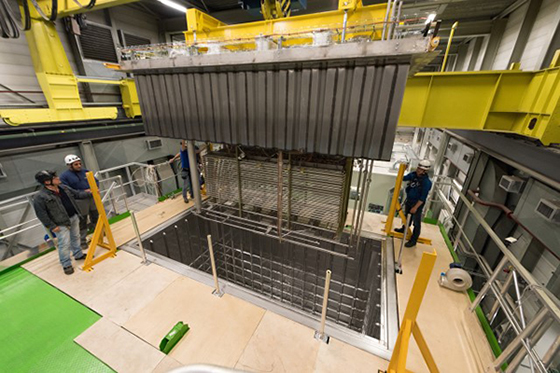A new era of global physics begins today, and a group of Wichita State University researchers is playing a key role.
On Friday, July 21, scientists, engineers and others from the U.S. Department of Energy’s Fermi National Accelerator Laboratory, the Sanford Underground Research Facility and their partners around the world gathered for simultaneous groundbreaking ceremonies for the Long-Baseline Neutrino Facility (LBNF) in Illinois and the Deep Underground Neutrino Experiment (DUNE) in South Dakota.
LBNF will be constructed over the next decade and will be home to DUNE. Using LBNF, Fermilab will send a beam of neutrinos 800 miles through the Earth to a detector at DUNE, which will stand nearly four stories tall, be built nearly one mile underground and be filled with liquid argon.
Scientists will study the interactions neutrinos make with argon atoms in a quest to learn more about these elusive yet abundant particles.
About 1,000 scientists and engineers from more than 160 institutions in 30 countries are part of this project, including WSU professors Holger Meyer, Nick Solomey and Mat Muether – along with WSU physics student Mauricio Alvarez; Bishop Carol High School senior Lindsay Smith; and WSU Summer Watkins Fellow Norman Schmidt from Tabor College.
They are working on computer simulations to design an auxiliary detector to measure with high precision the neutrino flux produced by LBNF.
Meyer says this flux spectrometer design study is a great applied learning opportunity for those with a strong interest but little to no background in particle physics involved in the LBNF / DUNE project and contribute a meaningful result within one summer.
Neutrinos are the most abundant matter particles in the universe, yet very little is known about their role in the way the universe evolved. DUNE will consist of two particle detectors placed in the world’s most intense neutrino beam. One detector will record particle interactions near the source of the beam, at Fermilab in Batavia, Illinois, while the other, filled with 70,000 tons of liquid argon and cooled to 300 degrees Fahrenheit, will take snapshots of interactions deep underground at Sanford Lab in Lead, South Dakota.
DUNE will enable scientists to look for differences in the behavior of neutrinos and their antimatter counterparts, antineutrinos, which could provide essential clues as to why we live in a matter-dominated universe – in other words, why we are all here, instead of our universe having been annihilated just after the Big Bang.
DUNE will also watch for neutrinos produced by supernovae, which scientists can use to look for the formation of neutron stars or even black holes.
The large DUNE detectors also will allow scientists to look for the predicted but never observed subatomic phenomenon of proton decay, a process closely tied to the development of a unified theory of energy and matter.
This research is funded by the U.S. Department of Energy Office of Science in conjunction with CERN and international partners from nearly 30 countries.


 Courtesy
Courtesy